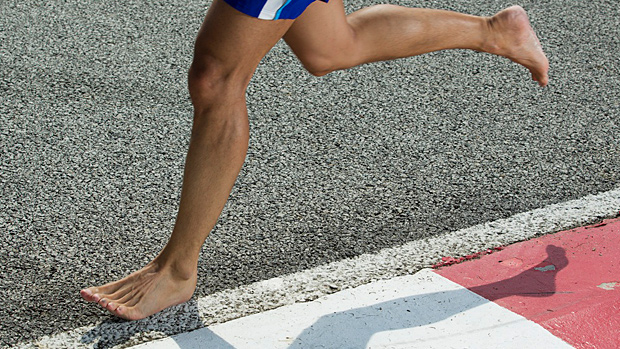You're a smart guy, right? You've been in the iron-game for a while now, you stay current by visiting websites like T Nation, you keep a training journal – and you're getting good results to show for it.
What if I were to tell you, however, that you're probably not making the best possible decisions, at least in some cases? It's also likely that you're unnecessarily avoiding beneficial methods, philosophies, and tools. And even further, if you're like most of us, the success you have achieved might not be due to the factors that you attribute it to.
I'm certainly guilty of all the above, and some of the brightest coaches and athletes I've known over the years admit making the same mistakes. So, do you think you're really immune to all this?
Before you answer that, have a look at my top 8 reasons that people do dumb stuff. As it turns out, you can't always trust your intuition to lead you to the truth.
Sometimes bad notions are rooted in truth, and this is a great example. After all, whenever you're engaged in the process of self-improvement, you need to get out of your comfort zone. And doing that, by simple definition, involves discomfort, right?
The problem is that we often extend this logic a few steps too far, and start assessing the value of our workout sessions by how much they hurt. This usually leads to poor decision making.
Case in point: Almost everything people do in the gym.
The average fitness novice assumes the following 3 activities are absolutely mandatory components of a sound fitness program: jogging, sit-ups, and static stretching.
While any or all of these activities might have a place in the proper context, for the most part, they're all vastly overrated for most people – and I don't do any of them myself. Have I been harmed by this decision? Possibly, but at age 52, I'm completely healthy, pain-free, and I'm capable of a 500-pound deadlift and banging out a set of 15 strict chin-ups, just for starters.
The list of questionable things we do in the name of pain is long indeed: forced reps, training to failure, long-duration jogging, Bikram yoga, P90X, compound sets, giant sets, drop sets, time-under-tension, high-rep Olympic lifts for time, 21's, non-lockout reps, fasted training, Super Slow training, should I continue?
Please don't miss my point – everything on this list can be potentially beneficial under the right circumstances and in the right context. The problem is, more often than not, the decision to do these things is rarely made for rational, evidence-based reasons – we find them appealing because they hurt, and dammit, if it hurts it must be good for us.
As legendary sprint coach Loren Seagrave pointed out, "It's easy to make an athlete hurt, but hard to make him fast." And this is precisely why the most common fallback of incompetent coaches and trainers is to inflict pain on their clients – it's easy, and usually expected by clients.
In fact, one of the most common questions that knowledgeable coaches ask me (usually in private) is, "Charles, all my clients seem to want is to feel like they've had their ass kicked, but what I want is to improve their fitness. How do I train them properly and satisfy their desire to be punished at the same time?"
I always try to explain to my clients that fitness is like running a business, in the sense that you get paid for what you produce, not how much pain was involved in the process. In other words, when you do (over a series of workouts) more work, you get fitter. Yes, that work might hurt sometimes, but it's not the primary goal – at least if you're smart.
Ah, how we worship all things natural, and vilify anything crafted by the hand of man.
Of course, the fact that you've even got enough free time to worry about such things (see Reason #3 below) stems from a number of decidedly "non-natural" advancements in the fields of health, medicine, and science.
After all, folks living in the many underdeveloped regions in the world don't lose sleep over whether there's mercury in their dental fillings, or if the eggs they're eating are from cage-free chickens.
Like spoiled teenagers rebelling against parents who've given them such an easy life that they're bored silly, we've turned against the very thing that's given us the luxury of intellectual masturbation: scientific technology.
Case in point: Barefoot training.

Not much is known about the earliest appearance of footwear in human history, probably because the materials involved don't preserve well over the eons. The oldest "shoe" ever discovered was about 9000 years old, however, anthropologists suspect that humans have been wearing footwear of one type or another for at least 40,000 years.(1)
A good argument can be mounted that footwear is so pivotal to the advancement of our species that it ranks perhaps only after fire and the wheel for importance. After all, the human foot is uniquely vulnerable to all manner of environmental dangers, including extreme temperatures, venomous creatures, and sharp rocks, just to name a few.
Who could've predicted then, that one of the more popular fitness trends in the past 10 years would be barefoot training? There may be good arguments for this practice, but in much the same way that men justify the purchase of a sexy sports car on safety features or good gas mileage, we often first become attracted to a particular idea based on irrational reasons and then try to justify it on more rational grounds.
Such is the case for barefoot training. Proponents claim that the use of shoes (traditional shoes anyway) significantly reduce proprioceptive feedback, impairing safe and efficient performance. Another claim is that shoes, over time, actually "deform" the foot in various ways, leading to a host of issues, including not only foot problems, but also more "global" concerns such as postural dysfunction and gait abnormalities.
While I'm not qualified to render recommendations about whether you should go barefoot during your next squat workout, I'm quite capable of lending some perspective to the discussion.
First, there are obvious social, safety, and public health concerns about going shoeless in public training facilities. One small accident (like dropping a 45-pound plate on your little toe) or picking up a nasty fungus or parasite can sideline your training for weeks or even months.
Second, for some people at least, habitually going shoeless can lead to problems like plantar fasciitis and a reduction in the foot's natural arch.
Finally, a number of resistance-training movements (such as squats) are made safer and more efficient when performed in appropriate footwear, such as weightlifting shoes with strong lateral stability and a raised heel. In the London Olympics for example, I didn't see a single weightlifter wearing Chuck Taylors, even though they're perfectly within the rules to wear.
Curiously (and in defiance of Reason #7 below), we've seen the emergence of specialized shoes such as the Vibram "Five Fingers" line of fitness footwear, popularized by another recent fitness phenomenon, Crossfit.
Manufacturers of these shoes (which often compartmentalized each toe in separate "fingers") claim that their products help to retain the benefits of training barefoot, while preserving the protective features of more traditional footwear. Whether this is true or not is beyond my scope of expertise, but if you ask me why I don't wear them, it's simply because I've never felt that I've been harmed or shortchanged in any way by wearing more traditional kicks.
In many countries, simple survival is more or less a full-time job – fending off life-threatening dangers such as hunger, crime, natural disasters, disease, and garden-variety poverty keeps people too busy to worry about things like postural dysfunction, BPA's, and "wheat belly."
In North America, however, things are very different. We're so affluent here for example, that even most people living below the poverty line still drive a car and carry a smart phone. No wonder then, that we get our panties in a wad about relatively minor concerns.
Case in point: Hydration & water purity.

Thirty years ago, when I was just starting my career in fitness, the idea of paying for bottled water would have struck the average person as crazy as, well, doing high-repetition clean & jerks for time.
Today, things are different. In fact, depending on what type of water you buy and where you buy it, water can often cost more than gasoline, which we all consider far too expensive. This despite the fact that by all rational standards, the free drinking water available to us all through our kitchen faucets is perfectly healthy.
So why are so many of us willing to pay such high prices for a commodity that's not ostensibly any better than what's available for free?
Two reasons:
First, those who make their living by peddling fear have convinced us that plain 'ol tap water is outright dangerous for a number of reasons, most notably the fluoridation of public water supplies.
Although the weight of scientific evidence doesn't support the notion that fluoride is a health risk in the way that most people consume it (2), many of us are scientifically illiterate (See Reason #8 below) and are prone to emotional and irrational interpretations about the world we live in.
Second, over the past few decades, we've been all but paralyzed by the idea that virtually all of us are chronically dehydrated and are suffering from a host of maladies as a direct result.
Now let's be clear – it's indeed possible to be chronically de- or under-hydrated, especially if you're an endurance athlete and/or live in an arid climate as I do. That being said however, the amount of press this imaginary epidemic garners is almost incomprehensible, relative to the actual dangers.
So, yes, hydration is important, at least in the sense that, if you never ingest any fluids, you'll die. But the idea that our water quality is killing us, or that none of us drink enough water, is utter nonsense.
On a personal level, I rarely drink water at all, and by all commonly touted assessments (urine color, skin elasticity, etc.) I'm more than adequately hydrated. I really have no idea what all the fuss is about.
It's no accident that health, fitness, and nutrition companies use celebrity endorsements to help market their products. Our brains are more irrational than they are rational, and even the most cynical among us are swayed by an athlete who looks like you want to look or perform like.
Case in point: Kinesio tape.

Referring again to the recent Summer Olympic Games in London, it's hard not to notice the large number of athletes wearing multicolored strips of tape all over their bodies. Developed by Japanese chiropractor Kenzo Kase, this flexible multicolored tape is purported to decrease pain and increase range of motion, among other things.
Science, however, remains undecided. Although one study (3) supported the idea that the tape did indeed live up to the manufacturer's claims, a more recent 2012 review (4) showed that there was scant evidence to support the idea that Kinesio tape had any advantage over more traditional athletic tape.
So why all the hype? I suspect it's a simple result of effective marketing procedures, and not much else. In his popular text Influence: The Psychology Of Persuasion, ASU Marketing Professor Robert Cialdini notes that product testimonials, especially when they come from people we admire and/or identify with, are enormously valuable, and indeed a critical component of effective marketing.
As it turns out, although Kinesio tape had been used by Olympic athletes since 1988, its popularity went viral when the company donated rolls to physical therapists to use on athletes at the 2008 Beijing Olympics. As Olympic athletes plastered in brightly colored stripes paraded across TV screens around the world, it wasn't long before the company's online sales tripled.
Now teams like the Green Bay Packers and athletes such as Lance Armstrong swear by the stuff, and that means you'll be intrigued to try it yourself. And I have no issue with that at all, as long as 1) you can afford the expenditure, and 2) you realize that famous athletes are successful for reasons that even they themselves often don't understand.
This common error is actually a component of Reason #8 below. Here's how it happens.
Let's say you're watching a professional basketball game, and you can't help but notice that pretty much every player on the court is exceptionally tall. You then conclude that the activity of playing basketball (which we'll call "A") causes tallness (which we'll call "B").
In truth (and obvious in this example but, trust me, not so obvious in many others), basketball doesn't cause tallness, but rather, is associated with it. Since tall people tend to be more successful at playing hoops, it's common to see tall people and basketball happening in the same place at the same time, and you therefore mistakenly believe that A causes B.
In the mostly non-rational world of fitness, many, many poor exercise and nutritional decisions are based on this error.
Case in point: Jogging.

I know I covered this activity in Reason #1 above, but jogging deserves special attention due to its very poor benefit-to-drawback ratio for most people, and because it's a great way to illustrate my point about causation versus correlation.
The evidence against jogging is so abundant it needn't be regurgitated here, but suffice it to say that jogging is probably the most effective form of non-surgical gender-reassignment available to those of you itching to explore your feminine side.
Jogging reduces strength, power, and muscle mass. It increases catabolic hormone output, punishes joints, and, in summary, basically reduces every commonly accepted marker of masculinity.
Apart from the undeniable pain factor, most people jog because many of the joggers they see are thin, and therefore believe that jogging causes thinness. Of course, the reality is that only thin people actually enjoy jogging, in much the same way that strong people enjoy lifting and flexible people enjoy stretching.
One curious artifact of living in an advanced society is the prevalence of simple guilt, which reveals itself in a number of interesting ways. We just have it so darn easy, and we can't help thinking that our luxurious lifestyles must have some sort of consequences. So we find ways to punish ourselves, and then justify that punishment through all manner of pseudoscientific, ethical, and/or environmental reasons.
Case in point: Raw veganism.
If I may be completely serious for a moment, why would anyone find himself attracted to the idea of abstaining from both animal products and cooking? It's one thing to be a vegetarian, which at least allows for things like a nice steaming bowl of oatmeal for breakfast or a tasty pasta dish for dinner.
But now we remove the option of cooking (which nearly every anthropologist of any repute would rank as one of the top 3 advancements in human history, along with the wheel and the development of language), and we've arrived at perhaps the most punishing type of nutritional regimen possible.
Raw (and non-raw) vegans claim nutritional, ethical, and environmental rationales for their avoidance of most healthy, great-tasting food, but none of them stand up to scientific scrutiny.
This is a very big subject, but for those interested in a very thoughtful and sober analysis of whether we're "meant" to consume meat, please see Dr. Michael Eades' excellent 3-part article, Are We Meat Eaters Or Vegetarians?
Another must-read is Lierre Keith's The Vegetarian Myth where the author, a former vegan, describes, among other things, how a bunch of eco-vegans pushed for the construction of a fence across the African continent for the purpose of partitioning predators from their prey (e.g., lions on one side, zebras on the other).
Against the wishes of more radicalized raw vegans, I'll allow you the freedom to make your own ethical choices, but suffice it to say that life can only exist when it exploits its environment, and this includes food.
Even limiting your diet to plants involves some form of agriculture, which comes at the expense of animals, either because animals are killed during the agricultural process, or because the plants that would've ordinarily be eaten by other animals are now being eaten by humans.
As a final bit of supporting evidence, it's worth remembering that carnivory is such a superior nutritional strategy that even dozens of plant species practice it.
This one is really a "two-fer" because they both go hand in hand. As a species, we seem to have an instinctive distrust of technology, and I suspect it's largely because we hate the idea that some greedy bastards are getting rich in the process.
In fact, many of the most popular horror movies are based on themes about "technology gone bad": the Frankenstein movies, Godzilla, and the nearly endless supply of zombie movies and television programs are just a few examples of this. Modern affluent humans love fear, and when there's nothing to be scared about, we just invent things to worry about.
Case in point: Aspartame/diet soda.

No nutritional subject generates more blind panic than diet soda. Even political and religious arguments rarely reach the fervor of diet soda debates. Most, if not all the arguments made against this marvel of nutritional chemistry are completely implausible and scientifically invalid.
I was told by one of my Facebook acquaintances that "aspartame is so dangerous, airline pilots are forbidden to drink it." Another told me that her mother recently died of cancer that was, according to her doctor, caused by diet soda consumption.
Recently, I advised a friend to have her overweight son switch from full-sugared sodas to diet sodas. In 3 weeks he lost 15 pounds, with no other changes in diet or activity levels. Upon learning of his conversion, one of the kid's teenage friends warned him that "those diet sodas are bad for you ya know – they're full of chemicals."
People love to claim that diet soda dehydrates you (it doesn't), can take rust off of metal (it might but who cares – your digestive system isn't made of metal), and causes everything from headaches/migraines, dizziness, seizures, nausea, numbness, muscle spasms, weight gain, rashes, depression, fatigue, irritability, tachycardia, insomnia, vision problems, hearing loss, heart palpitations, breathing difficulties, anxiety attacks, slurred speech, loss of taste, tinnitus, vertigo, memory loss, and joint pain, to holes in your brain.
Personally, I've been drinking the equivalent of 10 cans of Diet Coke a day ever since it came out 30 years ago – and I've yet to experience even one of these symptoms.
Am I advocating that you do the same? Not at all – I'd be the first to tell you that you'd be better off drinking water. But here's the problem: If you told 100 diet soda drinkers that their nasty little habit is going to kill them, most of them aren't going to switch to water because, frankly, water is boring.
Instead, they're more likely to switch to full-sugar soda, or maybe fruit juice. Both are far worse than drinking diet soda, due to their high sugar content. So, in much the same way that it's unethical to over-hype the dangers of air-travel (doing so leads some people to drive instead, which is far more dangerous), I find it irresponsible to scapegoat diet soda.
The research on aspartame (which is the primary culprit targeted by anti-diet soda fear-mongers) is abundant and just a few clicks away through Google Scholar or Pub Med. Here's a nice review to get you started: Aspartame: Review of Safety
This dovetails with the previous point insofar as we tend to fear what we don't understand. Many of us don't understand the mechanism or the value of science, and when that happens, we're left vulnerable to the less rational side of our brains. Much less rational, I should add.
Case in point: "Power" bracelets.

One particular scam that resurfaces every handful of years in slightly different disguises is the so-called "power bracelet." Typically, the manufacturers of these brightly colored bracelets claim a wide range of benefits from better balance to less pain from arthritis.
(By the way, are you noticing a pattern with the "brightly colored" theme here?)
At RMIT's School of Health Sciences recently, researchers reported the results of a study on one type of "holographic" bracelet that purported to improve an athlete's balance, of all things.
Using an independent, randomized and controlled trial with double blind design, they found absolutely no difference in balance between people using a "real" holographic wristband and those wearing a placebo.(5)
For those of you who spend way too much time on Facebook, you've no doubt seen one of the newer types of power bracelets being marketed to unsophisticated fitness consumers, the "ion bracelet."
From the website of one manufacturer's website, you'll learn just a few of the many purported benefits of the ion bracelet:
"Recently Dr. Oz spoke about the benefits of Ion therapy. It is proven to work, and it is very science based.
"Ion infused bracelets, also infused with minerals have been shown to potentially help with:
- Better Balance
- More Energy
- Increased Recovery after training/workouts
- Better Sleep Patterns
- Better Mood
- Less Anxiety"
However, a 2002 study by the Mayo Clinic made short work of the claims for ion bracelets, showing no difference in pain reduction between the ion bracelet and a placebo, concluding that the bracelets belong in the same category as astrology, channeling, mind-reading, fortune telling, divining rods, faith healing, and crystals, all of which are easily debunked superstition-based nonsense.(6)
I hope this article has encouraged you to develop a healthy appreciation for skepticism, and I also hope you'll see the value of thinking twice before simply accepting an idea without applying a bit of critical thinking first.
After all, many commonly practiced ideas – things that were taken as gospel only a few decades ago – are now dismissed as comical examples of human ignorance. It's worth pondering over which current practices and beliefs will suffer the same fate.
- History of Shoes.
- Yeung CA. A systematic review of the efficacy and safety of fluoridation. Evid Based Dent. 2008;9(2):39-43. PubMed.
- Thelen MD et al. The Clinical Efficacy of Kinesio Tape for Shoulder Pain: A Randomized, Double-Blinded, Clinical Trial. Orthop Sports Phys Ther. 2008 Jul;38(7):389-95. PubMed.
- Williams S et al. Kinesio Taping in Treatment and Prevention of Sports Injuries: A Meta-Analysis of the Evidence for its Effectiveness. Sports Med. 2012 Feb 1;42(2):153-64. PubMed.
- Brice SR et al. The effect of close proximity holographic wristbands on human balance and limits of stability: A randomised, placebo-controlled trial. J Bodyw Mov Ther. 2011 Jul;15(3):298-303. PubMed.
- Bratton RL et al. Effect of 'Ionized' Wrist Bracelets on Musculoskeletal Pain: A Randomized, Double-Blind, Placebo-Controlled Trial. Mayo Clin Proc. 2002 Nov;77(11):1164-8. PubMed.





